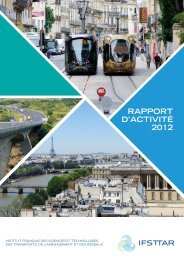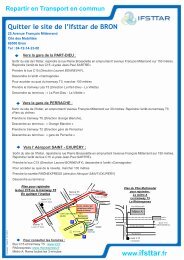french institute of science and technology for transport ... - Ifsttar
french institute of science and technology for transport ... - Ifsttar
french institute of science and technology for transport ... - Ifsttar
You also want an ePaper? Increase the reach of your titles
YUMPU automatically turns print PDFs into web optimized ePapers that Google loves.
2_SCIENTIFIC AND TECHNICAL ACTIVITIES<br />
Trams <strong>and</strong> road users<br />
A dangerous mix?<br />
The tram networks that are springing up in more <strong>and</strong><br />
more cities on the grounds <strong>of</strong> sustainable development<br />
have a drawback − an increasing number <strong>of</strong> collisions<br />
between trams <strong>and</strong> other road users.<br />
Two studies which were financed by the DGITM <strong>and</strong><br />
completed in 2011 have examined the interactions between<br />
road users <strong>and</strong> trams, from the st<strong>and</strong>point <strong>of</strong> tram drivers<br />
(Study 1) <strong>and</strong> <strong>of</strong> road users (Study 2). They both make recommendations<br />
<strong>for</strong> improving safety.<br />
The main difficulties encountered by the tram drivers are due<br />
to antisocial behaviour, a failure to comply with regulations<br />
<strong>and</strong> poor concentration on the part <strong>of</strong> the other road users<br />
(motorists, pedestrians, the users <strong>of</strong> 50 cm 3 motorized twowheelers<br />
<strong>and</strong> cyclists).<br />
In addition, 19% <strong>of</strong> road users are unaware <strong>of</strong> the priority rule<br />
<strong>for</strong> trams <strong>and</strong> do not see them as a potential danger due their<br />
low speed. This could partly explain their risky behaviour at<br />
locations <strong>of</strong> interaction with trams.<br />
The situation calls <strong>for</strong> increased communication about the<br />
regulations that apply to tramways. In addition, an action plan<br />
that sets out to modify attitudes <strong>and</strong> subjective norms would<br />
be helpful. More broadly, in the current economic <strong>and</strong> financial<br />
crisis, it is essential to examine the collective dimension <strong>of</strong><br />
safety <strong>and</strong> the energy-related <strong>and</strong> social implications <strong>of</strong> urban<br />
public <strong>transport</strong> policies.<br />
@ CONTACTS<br />
patricia.delhomme@ifsttar.fr & françoise.paran@ifsttar.fr<br />
a<br />
b<br />
a. A tram with priority.<br />
b. A wrong-way vehicle<br />
on the left.<br />
58<br />
+<br />
d’infos<br />
Find out more about<br />
the MOCoPo research<br />
programme at<br />
http://mocopo.ifsttar.fr/<br />
One <strong>of</strong> the zones on<br />
the N87 where a<br />
helicopter was used<br />
to measure vehicle<br />
trajectories.<br />
MOCoPo<br />
Traffic under surveillance<br />
How can we <strong>for</strong>ecast traffic congestion on motorways<br />
<strong>and</strong> measure how it will affect the level <strong>of</strong> pollution?<br />
This is the topic covered by the three-year PREDIT-funded<br />
MOCoPo (1) research programme which got under way<br />
in 2011.<br />
The first year <strong>of</strong> research has been devoted to collecting<br />
a large amount <strong>of</strong> data in the area near a highly congested<br />
motorway (the N87) in the Grenoble region. Pollution <strong>and</strong> extremely<br />
detailed traffic data were collected.<br />
In order to measure the traffic, a helicopter was positioned <strong>for</strong><br />
one hour above three zones on the N87 on five consecutive<br />
days. The resulting 15 hours <strong>of</strong> footage are currently being<br />
processed by s<strong>of</strong>tware developed by the Delft University <strong>of</strong><br />
Technology in the Netherl<strong>and</strong>s. This outputs the longitudinal<br />
<strong>and</strong> lateral positions <strong>of</strong> all the vehicles on the lane more than<br />
20 times a second by reidentifying vehicle trajectories over a<br />
(1) Measuring <strong>and</strong> Modelling Congestion <strong>and</strong> Pollution.<br />
length <strong>of</strong> 500m. The resulting data can be used to analyze car<br />
following behaviours, lane changes, acceleration <strong>and</strong> deceleration,<br />
none <strong>of</strong> which are accessible from conventional spot<br />
measurements.<br />
The pollution measurements were also highly sophisticated,<br />
combining very detailed knowledge <strong>of</strong> the vehicle fleet with<br />
knowledge <strong>of</strong> the emissions during fifteen days in each <strong>of</strong> the<br />
seasons at three points on the ring road with differing congestion<br />
levels.<br />
2012 <strong>and</strong> 2013 will be spent validating <strong>and</strong> improving our<br />
congestion <strong>and</strong> pollution <strong>for</strong>ecasting models. The project will<br />
end with the drafting <strong>of</strong> a series <strong>of</strong> recommendations <strong>for</strong> minimizing<br />
the possible adverse impacts (delays, pollutant emissions,<br />
safety problems) <strong>of</strong> traffic on high speed urban roads.<br />
@ CONTACT<br />
christine.buisson@ifsttar.fr<br />
ifsttar French Institute <strong>of</strong> Science <strong>and</strong> Technology <strong>for</strong> Transport, Development <strong>and</strong> Networks






![Trajectoire le magazine n°3 - Juillet 2012 [.pdf] - Ifsttar](https://img.yumpu.com/30038493/1/190x253/trajectoire-le-magazine-na3-juillet-2012-pdf-ifsttar.jpg?quality=85)

